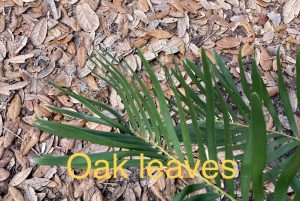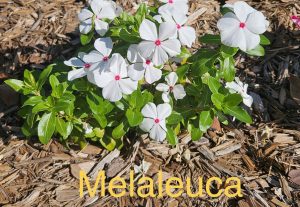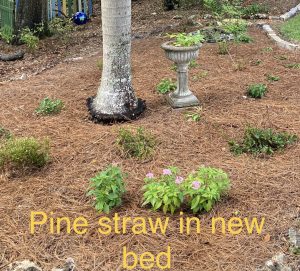The answer might be – it depends! Are you mulching a large landscape bed of trees or shrubs, or more delicate annuals or perennials? Are you creating a mulched pathway? Do you have a wildflower area? Read on for a few facts, tips and myths about mulch choices. For more complete information, check out the links below.
FACTS
- Mulches come in different textures, sizes, methods of processing, and have different effects on your plants and soil. Learn which mulches fit your needs.
- Addressing the elephant in the (garden) room, the use of dyed mulches has been a topic of interest for some time. Research from the University of Florida shows no evidence that the dye used to add color to mulches is harmful to soils. The problem with dyed mulch can come from the wood itself. Many dyed mulches contain recycled wood from pallets and recycled building materials that have been treated or contaminated with CCA (chromated copper arsenate). This substance is toxic to humans and animals. Colored mulch is not recommended unless certified with MSC Certification logo, stating the mulch is free of CCA treated wood. Look for this label on the front of mulch bags.
- If your goal is to enrich your soil and improve its health, the size of the material (how quickly it breaks down), and the type of wood (nutritional value) are factors to consider.
- Help Florida’s environment by using sustainably produced mulches. See links below for descriptions on choices such as melaleuca, eucalyptus, and more!

TIPS
- Be realistic in your expectations from the use of mulch. There probably isn’t a “perfect” mulch. Mulches help manage weeds; not completely eliminate them. Mulches will tend to fade as they age; this is to be expected. Some mulches can pack down and need raking up to loosen from time to time.
- Mulches that have been produced by shredding tend to pack tightly together. They are great for paths, and large areas between trees and shrubs. Shredded mulch is also good for erosion control on slopes.
- Mulches that are produced by cutting into chips (e.g., pine bark) tend not to compact as tightly as shredded forms. They are great for beds of smaller plants such as annuals and perennials.
- Add visual interest and have fun “mixing and matching” mulches throughout your landscape.
- Are you planting wildflowers? Use thin layers of mulch so seeds have access to natural soil. Pine straw, fallen leaves and mini pine bark are good choices. Leave some bare spaces available for ground-nesting bees.
A FEW MYTHS
- If a little mulch is good, more mulch is better. In fact, mulch that is too thick can be quite problematic for your plants by impeding water from reaching plant roots and by increasing disease/pest issues. Florida-Friendly Landscaping recommends a mulch depth of 2-3 inches. In all mulched beds, the best practice is to periodically rake and break up old mulch. If aesthetics are desired, you can remove old mulch and add fresh to aim for the recommended depth of 2-3 inches. The old mulch may still be useful, used in another less visible area or used as compost. Always avoid piling mulch against the center of all plants, including the trunks of trees! This harmful practice can lead to increased diseases and pests, eventually even the death of the plant. You can read about this harmful mulching practice in the link below on “Volcano Mulching”.
- Cypress mulch is a good mulch to choose. The University of Florida does not recommend the use of cypress mulch or any shredded mulch that includes cypress. The origin of cypress mulch is often difficult to determine, and it could come from Florida’s ecologically sensitive forested wetlands. Again, read the label on mulch bags.
Organic mulches are an important and beneficial addition to Florida Friendly Landscapes. Which mulch materials are just right for your yard? Read sources below to further your knowledge and understanding of using organic mulches in your Florida-Friendly Landscape and choose the mulch(es) that work best for you. Happy Gardening!

Sources:
Florida-Friendly Mulches and Their Uses
For more information, contact UF/IFAS Extension Polk County at (863) 519-1041 or visit us online at http://sfyl.ifas.ufl.edu/polk. The Plant Clinic is open Monday-Friday, 9:00 am-4:00 pm to answer your gardening and landscaping questions. Give us a call or email us at polkmg@ifas.ufl.edu.
If you are not in Polk County, Contact your local UF/IFAS Extension Master Gardener Volunteer Plant Clinic.
The Florida Master Gardener Volunteer Program is a volunteer-driven program that benefits UF/IFAS Extension and the citizens of Florida. The program extends the vision of the University of Florida/Institute of Food and Agricultural Sciences, all the while protecting and sustaining natural resources and environmental systems, enhancing the development of human resources, and improving the quality of human life through the development of knowledge in agricultural, human and natural resources and making that knowledge accessible.
This article was written by Master Gardener Volunteer Molly Griner under supervision of the Master Gardener Volunteer Coordinator and Residential Horticulture Extension Agent Anne Yasalonis.
An Equal Opportunity Institution.
 2
2

